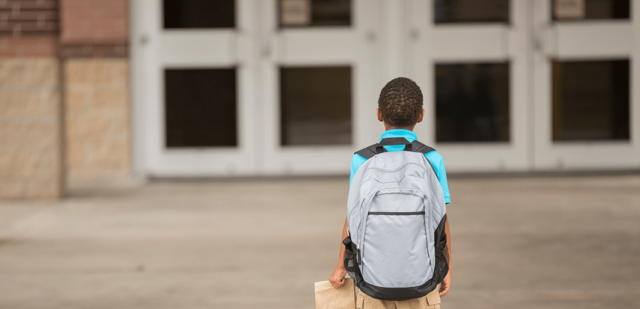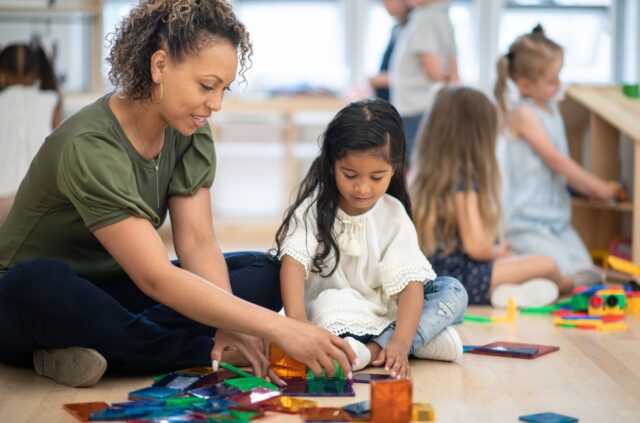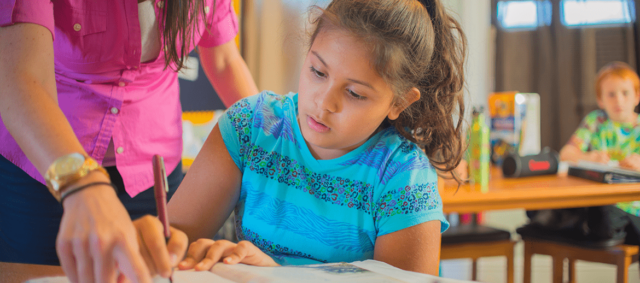Selective Mutism and Starting Kindergarten
What to do to help kids with SM transition to elementary school
Clinical Expert: Kathryn L. Keough, PhD
en EspañolKey Takeaways
-
If you have a child with selective mutism, you’ll want to reach out to the school staff to talk about your child and the support they might need.
-
Arrange for a classroom visit with their teacher one-on-one, before school starts.
-
Plan ahead for accommodations at school, like using communication cards, if your child needs them.
Starting kindergarten is both an exciting and nerve-wracking time for young kids and their families. If you have a child with selective mutism (SM), you may find that the transition from preschool to kindergarten feels particularly daunting. Kindergarten typically involves a lot of change — new teachers, classmates, and in many cases, a new school altogether. These kinds of changes are especially difficult for young kids with SM, who speak comfortably at home but find it very difficult to speak in other situations.
Some kids with SM may have made progress talking in preschool, but will still find it challenging speaking to a brand-new kindergarten teacher, for example. And finding their way around a new building and classroom can be particularly hard if they aren’t able to speak up to ask for help. Fortunately, there are steps that parents can take to help children with SM have a more successful transition into kindergarten.
Communicate early with the school
Most schools won’t send out a child’s kindergarten teacher assignment or the class list until close to the start of the school year. If you have a child with SM, you’ll want to reach out to school staff earlier. If you don’t know your child’s teacher assignment yet, you can reach out to the principal and school psychologist/counselor to do the following:
- Share information about SM. If you have a child with a diagnosis of SM, it is important to share this information with your child’s new school. Transparency is key to foster empathy, understanding, and a team approach. Not all educators are familiar with SM, so it can be helpful to share information about what SM is, in addition to some of the “dos and don’ts” for supporting a child with SM at school. Our Teacher’s Guide to Selective Mutism is a great place to start!
- Give a fuller picture. You want the staff at the school to know your child, not just their SM struggles. Sharing information about your child’s interests and a video of your child talking and playing normally at home can help the school get a full picture of your child, beyond the SM.
- Connect your team. If your family is working with an outside therapist or counselor, you’ll want to introduce them to your child’s new school as well. They may be able to provide additional training or resources for school-based staff.
- Ask about supports. It’s a good idea to ask the school if they’ve had other students with SM before, and what they may recommend or require of you to provide the supports your child needs. States and school districts have different ways of evaluating and intervening when an anxiety disorder impacts a child at school. Some schools may recommend a Section 504 plan or Individualized Education Program (IEP). Parents interested in formalizing accommodations or interventions for their child with SM can ask schools for more information and request a 504 plan or IEP evaluation, if applicable.
Build comfort before school starts
Children with SM fare best when we take steps to help them build familiarity with new people and places in a gradual way. Reach out to your child’s school and let them know that your child will be much more comfortable if they can meet the teacher briefly and see the classroom before the crowded, chaotic first day. Some schools even offer orientations or “meet the teacher” days for all incoming kindergarteners!
- Arrange a school and classroom visit. Bringing your child for a visit to school ahead of the first day gives them the chance to get comfortable there, especially if they can check out their new classroom and other important places (e.g., the bathroom, their cubby, where they’ll be dropped off). When you have a child with SM, you’ll want to see if you can get your child talking to you in the school building and in their new classroom. Having successful experiences talking to you in the classroom can help pave the way for “brave talking” progress at school.
- Meet with the kindergarten teacher. Try to find a brief time when you and your child can meet the new teacher. Not all children will be able to talk to the teacher during this first interaction, and that is okay. Maybe you bring your child’s favorite game along and play together, which takes some of the pressure off and provides structure, predictability, and a sense of familiarity for your child. If your child is able to talk to you in the presence of the teacher and seems ready for it, maybe you give the teacher a question to ask your child. You can have your child answer those questions at home beforehand to build confidence through practice.
- Connect with classmates. You may know some kids from the neighborhood or from your child’s preschool class who will be starting kindergarten at the same school. If you’re able, setting up playdates or coordinating times to meet up at the park together is a great way to help ease your child’s transition into kindergarten. If your child is ready, try to build their comfort and get them to talk in front of or directly to their classmates. No matter what level of talking happens, your child will benefit from the extra familiar faces on day one!
Plan ahead for appropriate accommodations
Appropriate accommodations for a child with SM are temporary supports that reflect what a child needs to set them up for success at school. This might include things like using alternative forms of communication (e.g., the use of nonverbal signals or communication cards) or regular prompting for bathroom breaks, among others.
As kids make progress speaking at school, we want to gradually reduce these accommodations. This helps your child become more confident in the classroom and continue making progress toward overcoming SM. For example, a child who can speak to their teacher and classmates should not be using communication cards in the classroom, but they may still need the cards to communicate with their teachers in special classes like art and music. The appropriate level of accommodations can be challenging for parents and schools to determine — mental health professionals with expertise in SM can give guidance.
Every child is going to be in a slightly different place on their SM journey at the start of kindergarten. Though some back-to-school stress may still be inevitable, communicating with the school and planning ahead to ensure your child has the supports they need can ease your child’s (and possibly your own!) anxiety.
Related Reading
-
 Starting Elementary School
Ten tips to make the transition to kindergarten easier for your child
Starting Elementary School
Ten tips to make the transition to kindergarten easier for your child
-
 Tips for Helping Kids With Selective Mutism Go Back to School
What to tell the teacher and how to ease kids back in
Tips for Helping Kids With Selective Mutism Go Back to School
What to tell the teacher and how to ease kids back in
-
 Back-to-School Anxiety
How to help kids manage worries and have a successful start to the school year
Back-to-School Anxiety
How to help kids manage worries and have a successful start to the school year
-
 Quick Guide to Selective Mutism
A brief overview of the signs and symptoms of selective mutism, as well as treatments.
Quick Guide to Selective Mutism
A brief overview of the signs and symptoms of selective mutism, as well as treatments.
-
 Complete Guide to Selective Mutism
Children with selective mutism (SM) are talkative at home but unable to speak in more…
Complete Guide to Selective Mutism
Children with selective mutism (SM) are talkative at home but unable to speak in more…
-
 How Anxiety Affects Teenagers
Signs of anxiety in adolescents, and how they're different from anxious children
How Anxiety Affects Teenagers
Signs of anxiety in adolescents, and how they're different from anxious children
-
 Teacher’s Guide to Selective Mutism
In this guide we explain what SM looks like in the classroom and offer tips…
Teacher’s Guide to Selective Mutism
In this guide we explain what SM looks like in the classroom and offer tips…
-
 Is Your Child Ready for Kindergarten?
Tips to help parents decide when a child is mature enough for school
Is Your Child Ready for Kindergarten?
Tips to help parents decide when a child is mature enough for school
-
 What Is a Behavior Intervention Plan?
A BIP is a plan to help children whose problem behavior in school is affecting…
What Is a Behavior Intervention Plan?
A BIP is a plan to help children whose problem behavior in school is affecting…
-
 When Kids Refuse to Go to School
How to recognize what's called 'school refusal' and how to get kids back in class
When Kids Refuse to Go to School
How to recognize what's called 'school refusal' and how to get kids back in class
-
 Twice-Exceptional Kids: Both Gifted and Challenged
2e kids, as they’re called, have a unique set of issues that need addressing
Twice-Exceptional Kids: Both Gifted and Challenged
2e kids, as they’re called, have a unique set of issues that need addressing

